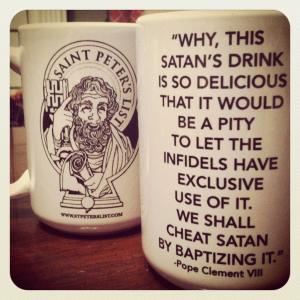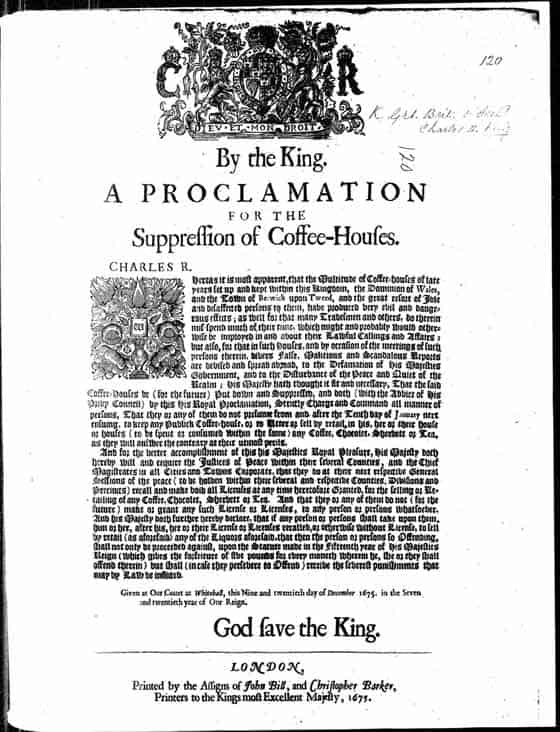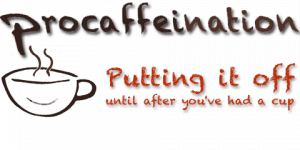My wife mentioned how writing about coffee was writing about a legal drug! Being kind of a trivia guy, I mentioned that there have been times when coffee WAS illegal. And then that got me thinking, so I did a little research and here’s what I found.
There have been numerous times throughout history where coffee was restricted, banned, or downright illegal. I am going to fill you in on the details, but you might be surprised to find out the real reasons behind the prohibitions. In fact, they almost always had to do with money and quelling political turmoil and dissent and usually had nothing to do with the coffee itself!
When Coffee was Only from Yemen
The coffee plant originally comes from Ethiopia. You may have heard of the story of Kaldi the goat herder, the supposed discoverer of coffee? Well, the Ethiopians used coffee to create a sort of energy bar which they ate for a midday boost. It was Sufi monks who came up with the genius idea of roasting,
That didn’t change until 1616 when the Dutch East India Company merchant, Pieter van der Broecke swiped a few plants as he was leaving Yemen. These plants became the basis for the coffee that was later grown in Java, sending coffee on its way to becoming a global phenomenon. Another good story is how Baba Budan, a Sufi saint, smuggled seven live seeds back to India, eventually turning it into one of the largest coffee producing nations. My favorite version of the story – there
Political Unrest and Coffee
“One of the most interesting facts in the history of the coffee drink is that wherever it has been introduced it has spelled revolution. It has been the world’s most radical drink in that its function has always been to make people think. And when the people began to think, they became dangerous to tyrants and to foes of liberty of thought and action.”
William Harrison Ukers, All About Coffee, 1935
As it was the center of the Muslim world, Mecca also became the center of the coffee world. Eventually, average citizens began to drink coffee on a regular basis and those who were politically in charge noticed the beginnings of a problem. Coffee houses were inexpensive and lacked the usual social restrictions, allowing diverse classes to mix with one another. People were sitting around and talking. People were sitting around and complaining. Inevitably, p
Arabia
In 1511, Kha’ir Beg al-Mi’mar, governor of Mecca, saw a group of coffee drinkers preparing for a night of prayers. Citing both religious prohibitions and purported health concerns he ordered the coffee houses of Mecca to be closed. Further, he ordered that all the coffee found in the shops or in merchants’ warehouses to be burned. He was shortly overruled by the Sultan of Cairo and later tortured to death. So, justice was served?
In 1524, because of disturbances, the powers that be once again closed the coffee houses. Coffee drinking at home and in private was not affected by the order. When a new qadi (judge) was installed, they were reopened. In 1542, Soliman the Great issued an order forbidding all use of coffee. This order was largely ignored when it came to light that he had been tricked into signing it by one of the ladies of the court.
All was good until about 1570 when, noting that the mosques were almost empty, while the coffee houses were always full, religious leaders finally had coffee forbidden by law. This, of course, pushed coffee drinking underground and the coffee equivalent of speakeasies became the norm. When more enlightened leadership removed the interference, coffee became a significant source of governmental revenue.
Religion and Coffee

Eventually, coffee came to Europe, providing us this possibly apocryphal tale from the year 1600: Due to its deep-seated Muslim roots the Catholic clergy called coffee “the devil’s brew.” They encouraged Pope Clement VIII to place a ban on coffee but upon taking a taste he declared it was delicious, even joking, “We shall fool Satan by baptizing it and making it a truly Christian beverage.” On the strength of the papal blessing coffee houses rapidly sprang up throughout Europe.
Ottoman Empire
In 1633, Ottoman Sultan Murad IV, no longer under the control of corrupt advisors, cracked down on the coffee shops. You know… because of the plotting and sedition (see above). Some accounts report that he would go out at night and personally execute anyone engaged in the illicit activity. Drinking coffee at home was OK though.
In 1656, during the war with Candia, and for largely political reasons, Grand Vizier Kuprili closed the coffee houses and prohibited coffee. This time, the prohibition was enforced. For the first violation the punishment was cudgeling. A second infraction got the offender sewn into a leather bag and thrown into the Bosporus.

Europe and England
In December 1675, Charles II of England issued a proclamation banning coffee houses. As is often the case, the political discussions in them worried the man at the top. These “Seminaries of Sedition,” as he called them, were known as “penny universities” to the patrons. For the price of a cup of coffee, polite conversation and reasoned debate on matters of politics, science, and religion could be had with the likes of Alexander Pope and Isaac Newton.
Coffee was banned by the Ethiopian Orthodox Church some time before the 18th century. However, in the second half of the 19th century, Ethiopian attitudes softened towards coffee drinking. Its consumption spread rapidly between 1880 and 1886 and according to Richard Pankhurst, “this was largely due to Emperor Menilek, who himself drank it, and to Abuna Matewos who did much to dispel the belief of the clergy that it was a Muslim drink.”
The Enlightenment and Coffee
Frederick I of Sweden levied high import taxes on coffee and tea in 1746. Those who did not pay had their pots and cups confiscated. Later that same year, coffee was banned outright. This, of course, resulted in a brisk black market. Penalties against coffee drinking were made even stricter in 1766 under King Adolf Frederick who reigned from 1751-1771. His successor, King Gustav III, like any enlightened ruler, sought to prove the health dangers of coffee through science with his famous twin experiment. The results were inconclusive
Proto-Germany
King Frederick the Great of Prussia personally liked coffee, although he did have a very strange recipe for it. It involves champagne and mustard! In 1777 he issued a “Coffee and Beer Manifesto” recommending that the lower classes focus exclusively on the beer part. It seems he had noticed how much money was going out of the country to pay for the coffee and realized that if they bought beer instead, he would make a packet. In 1781 he established a state coffee roasting monopoly in plants in Germany and forbade commoners from roasting their own. He hired approximately 400 disabled soldiers to work as “sniffers” to catch anyone roasting without a permit.
On the other side of what would become Germany, Maximillian Frederick, the Elector of Cologne, in 1784 issued a prohibition against the use of coffee except by the rich. As you might guess, fines and prison awaited those who were caught.
In the early 1900s, it wasn’t so much the coffee as the meetings. Finnish women used illegal coffee parties to meet and plan civil disobedience and resistance against the Tsarist regime that ruled Finland at the time.
Modern Challenges to Coffee
For a while in 2013 your coffee was not illegal but getting sugar in it was. New York City’s short-lived ban on sugary drinks, while not being aimed directly at coffee, complicated orders inside the city limits. McDonald’s and Dunkin’ Donuts no longer added sugar to the large and extra-large hot beverages, however, you COULD add your own. Sweet beverages like hot chocolate were only available in small and medium sizes.
Currently, distracted driving laws are beginning to come into conflict with our drive-thru lattes. At the time of this writing, no states have said that drinking coffee while driving is per se distracted driving, but hey, I’m no lawyer… seek competent legal representation! And drive safely, too. Someone’s life is at stake.
Underage drinking of coffee is now starting to get attention. It is not illegal now but it is best to keep an eye on this one.
In conclusion…
So as you can see, coffee is almost always collateral damage. Either the customers at the coffee house are now thinking straight because they are no longer drinking beer all day and that makes the leadership nervous. Or possibly, they are thinking straight and talking to each other and realizing that the guys at the top are not as overly bright or altruistic as they thought they were and maybe it’s time for a change and that REALLY makes the leadership nervous. Maybe it’s simply a cash grab. Or maybe the leadership does think they are looking out for poor unwashed masses. But it’s never really about the coffee.

